A twist of the magic bedknob takes us around the world for 50 years of the Disney classic in story and song, on gleaming vinyl.
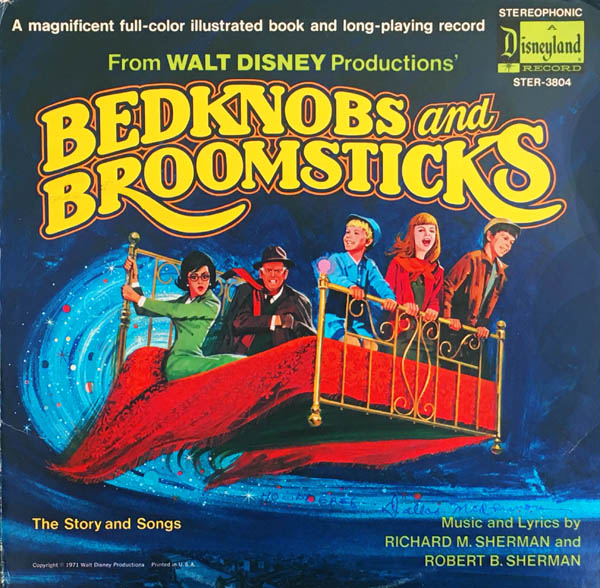
From Walt Disney Productions’
BEDKNOBS AND BROOMSTICKS
The Story and Songs
Disneyland Records – Storyteller Series STER-3804 (12” 33 1/3 RPM / Stereo)
Released in August, 1971. Executive Producer/Writer: Jimmy Johnson, adapted from the screenplay by Bill Walsh, Don DaGradi, based on The Magic Bedknob and Bonfires and Broomsticks by Mary Norton. Producer/Musical Director: Tutti Camarata. Orchestrations: Brian Fahey. Recorded at Sunset Sound, Hollywood and Abbey Road, London. Running Time: 38 minutes.
Performers: Dal McKennon (Emelius Browne/Narrator); Mike Sammes (Emelius Browne/Singing Voice); Judy Carne (Eglantine Price/Singing Voice); The Mike Sammes Singers (with Enid Heard, Irene King, Marion Madden, Mike Redway, Ross Gilmour and Valerie Bain). Orchestrations: Brian Fahey.
Songs: “With a Flair,” “The Age of Not Believing,” “Eglantine,” “Portobello Road,” “The Beautiful Briny,” “Substitutiary Locomotion,” “The Old Home Guard” by Richard M. Sherman, Robert B. Sherman.
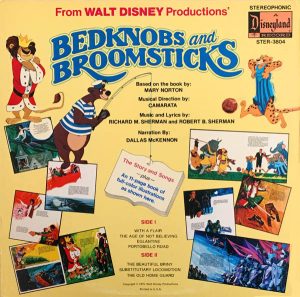 Fifty years has been more than enough time for Bedknobs and Broomsticks to beam outside the shadow of its spectacularly successful 1964 predecessor, Mary Poppins. For years after its premiere in late 1971 (a limited release followed by a wide release in Spring 1972), Bedknobs attracted comparisons, as did 1968’s Chitty Chitty Bang Bang, because of the similarities. Time has allowed it to gain a life of its own.
Fifty years has been more than enough time for Bedknobs and Broomsticks to beam outside the shadow of its spectacularly successful 1964 predecessor, Mary Poppins. For years after its premiere in late 1971 (a limited release followed by a wide release in Spring 1972), Bedknobs attracted comparisons, as did 1968’s Chitty Chitty Bang Bang, because of the similarities. Time has allowed it to gain a life of its own.
Certainly it has found a comfortable berth among the Harry Potter stories and numerous family-friendly fantasy films and TV shows of the years since. It has become as much an Angela Lansbury movie as a Disney film, since its star has amassed such acclaim on stage, screen and television, cementing her Disney Legend status as Mrs. Potts in Beauty and the Beast.
The broomstick rides to get Bedknobs on the screen were bumpy for almost all concerned, and much of this was discussed in this Animation Spin about the soundtrack album and this one about the “second cast” album (this was Disney’s term for a “studio cast,” or a non-soundtrack version of a film story or musical score). This is a look from the perspective of Disney Storyteller albums, 12-inch long-playing records with gatefold covers containing storybooks, to provide yet another insight, into how one creative product evolves on a parallel track with another creative project while each keep changing, how well those challenges are met–and how the seams sometimes show.
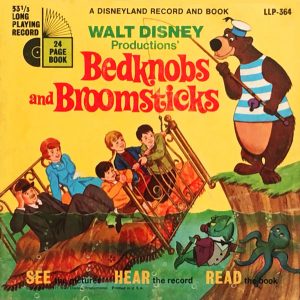 When a project as big as Bedknobs and Broomsticks goes into motion, thousands of other activities go into action for months (sometimes years) before the cameras roll. Printing, publishing, manufacturing and all forms of production have to be planning far in advance, sometimes when there are limited support materials available, like scripts and visual references.
When a project as big as Bedknobs and Broomsticks goes into motion, thousands of other activities go into action for months (sometimes years) before the cameras roll. Printing, publishing, manufacturing and all forms of production have to be planning far in advance, sometimes when there are limited support materials available, like scripts and visual references.
That’s one of the reasons there were some elements missing from various Disneyland Records. No background music? It may not have been scored in time. A character looks different? It might have been redesigned between the print deadline and the film’s final cut.
Often there are scenes and songs that never end up in a film. In the case of Bedknobs and Broomsticks, these circumstances seemed to multiply, much to the fascination of enthusiasts for years as “lost” elements were researched. Our colleague Jim Fanning, an authority on the film, shared some of his vast knowledge here.
Disneyland and Buena Vista Records were part of the massive merchandising and promotional plans for the original release of Bedknobs and Broomsticks. It turned out to be the last Disney project to receive the full treatment (“original cast sound track” album on Buena Vista Records to “second cast” album, Storyteller book and LP, read-along book and 7” LP and two four-song 7” LPs) by the original founding team behind Disney’s in-house record label.
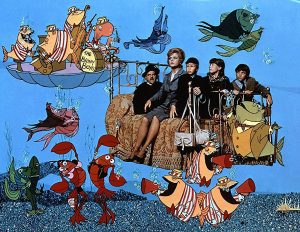 Several songs were cut from the film but were already included on the records. In the case of the Disneyland second cast album, the songs “With a Flair” and “A Step in the Right Direction” are included (“With a Flair” begins the Storyteller). All of the intervening months of changes took place while the albums were being made and distributed.
Several songs were cut from the film but were already included on the records. In the case of the Disneyland second cast album, the songs “With a Flair” and “A Step in the Right Direction” are included (“With a Flair” begins the Storyteller). All of the intervening months of changes took place while the albums were being made and distributed.
One of the most curious mysteries is the image of Eglantine Price on the cover of the storyteller, seen with short, dark hair and glasses (more like “Diana Prince” of Wonder Woman than Miss Price), while Emelius Browne strongly resembles David Tomlinson. Inside, the costume and hair style for Miss Price is more accurate, though her hair is darker.
In this video, Jim Fanning explains the various recordings and mentions the appearance of the mysterious Miss Price on the Storyteller. He suggests that Miss Price may not look the same because Lansbury does not appear on the album. This is very true of “cover” versions of most musical score albums on other labels. With few exceptions, the art or models on the cover may suggest but not look exactly like the real people. However, the Miss Price on the Disneyland album Songs from Bedknobs and Broomsticks (STER-1326) bears more of a resemblance to the film character than the image on the Storyteller, plus that LP has actual film stills on the back cover.
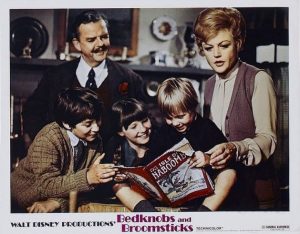 The reasons for this are so complicated and varied they could be only be pieced together through research that would have to be tracked on a timeline based on contracts, approvals, revisions and other variables. The record company had to have something on the store shelves; they had to use what was available to meet demand and deadlines.
The reasons for this are so complicated and varied they could be only be pieced together through research that would have to be tracked on a timeline based on contracts, approvals, revisions and other variables. The record company had to have something on the store shelves; they had to use what was available to meet demand and deadlines.
Jim told me that both Lansbury and Tomlinson were signed to star in the film long before the albums were released. It is possible that it was painted when several lead actors were being considered for Eglantine, including Julie Andrews, Lynn Redgrave and Laugh-In TV star Judy Carne (who did appear on the song album and Storyteller versions as, in effect, Miss Price’s singing voice). Another possibility is that, sometime during the process, there may have been hesitation to have illustrations of Miss Price resemble Lansbury at all until they had permission. (obviously they already had clearance for Tomlinson). In addition, the Eglantine costume (which by the way, was modeled on stage on the Academy Awards telecast as the Best Costume awards were being read) may not have been completed between the drawing of the cover art and the interior book, as both are created separately (there is even a movie poster in which Lansbury is dressed in contemporary garb).
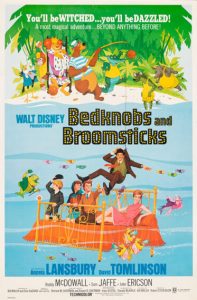 For those of us so deeply immersed in the chronology of Disney records that they seem serialized, the Storyteller for Bedknobs holds a certain touch of melancholy. It is the final collaboration between the founder of the division, Jimmy Johnson, who also wrote the script; musical director/producer Tutti Camarata; The Mike Sammes Singers; and narrator Dal McKennon, who had become a fixture of Disneyland Records since 1957.
For those of us so deeply immersed in the chronology of Disney records that they seem serialized, the Storyteller for Bedknobs holds a certain touch of melancholy. It is the final collaboration between the founder of the division, Jimmy Johnson, who also wrote the script; musical director/producer Tutti Camarata; The Mike Sammes Singers; and narrator Dal McKennon, who had become a fixture of Disneyland Records since 1957.
As Emelius Browne, Dal narrates in first person (just as he did for Mary Poppins, 20,000 Leagues Under the Sea, The Jungle Book and many other albums) for the last time. He gives his customary energetic, genial performance, but is not afforded a few moments to recreate his film voice role as the Bear on Naboombu island. He also makes a faux pas that must have been missed, saying “Substitutiary Locomotion” correctly throughout the story except for the first time, when he calls it “Substitue-shrue-rarey Locomotion.” Also curious in Johnson’s script, is the reference to ‘the age of non-believing” rather than “not believing.”
Like the film, the Storyteller LP of Bedknobs and Broomsticks reflects the foggy transition period in which it was created. In hindsight, the image of a misty landscape with hundreds of suits of armor moving steadily forward, with no one apparently inside them, conjures all manner of metaphoric elaboration.
“A Step in the Right Direction” – The Mike Sammes Singers
This was supposed to be the first song heard in the film, after Miss Price rushed downstairs to open her parcel and received her first broom. Her failed attempts to ride it inspire her song. In the filmed version it provided a background melody for the flying sequence. The Mike Sammes Singers, who sang back up for The Beatles and a galaxy of music stars, as well as were Here Comes Peter Cottontail and Santa Claus is Comin’ to Town, two Rankin/Bass classics we discussed in recent Animation Spins, perform this deleted song in a Cockney accent in the manner of a British pub sing-a-long. Note how the arrangement comes to a close—it suggests the end theme to Total Television’s Commander McBragg.
DONNER UN PEU D’ÉCOUTE
Lagoon sequence excerpt from the French Storyteller LP, “The Witch Apprentice”
The French Bedknobs and Broomsticks Storyteller album seems to have been planned to combine the Camarata/Sammes music with narration, but the soundtrack and dialogue mix must have become available after the art went to the printer, so the record presents narration, songs, dialogue and background music. This is a brief excerpt from the underwater segment:
GEBEN SIE EIN KLEINES ZUHÖREN
Soccer sequence excerpt from the German Storyteller LP, “The Reckless Witch”
In this version, an announcer was added to “call” the Naboombu soccer game as if it were a sports broadcast, rather than with sound effects and some dialogue alone as in the English language version. From the ambience, this announcer sounds as if he is part of the film track rather than narration created just for record listeners. (Also in the German translation, “Eglantine” is called “Caroline.”)
Special thanks to Stacia Martin and Jim Fanning for their assistance with this article.


 GREG EHRBAR is a freelance writer/producer for television, advertising, books, theme parks and stage. Greg has worked on content for such studios as Disney, Warner and Universal, with some of Hollywood’s biggest stars. His numerous books include Mouse Tracks: The Story of Walt Disney Records (with Tim Hollis). Visit
GREG EHRBAR is a freelance writer/producer for television, advertising, books, theme parks and stage. Greg has worked on content for such studios as Disney, Warner and Universal, with some of Hollywood’s biggest stars. His numerous books include Mouse Tracks: The Story of Walt Disney Records (with Tim Hollis). Visit 






















































Bedknobs and Broomsticks has long been one of my all-time favorite Disney films. As I have mentioned previously, there is a big difference between the general release version of this film and the restored version which was presented on DVD several years back. The restored version is longer and includes many songs and sequences that were cut from the film in its first release. Some of the restored footage needed to be re-dubbed, and it is fascinating to note that, while the parts of Tomlinson and the children as well as other incidental characters were voiced by different actors for the restored scenes, Miss Lansbury and Roddy McDowall were available to re-dub their own lines. For me, these restorations make sense and improve the film, making the motivations and plot workings more comprehensible. Others prefer the shortened version. (Sadly, the footage for “A Step in the Right Direction” was never unearthed, but the song itself is re-created as a bonus feature and for those who are complete-ists, it is possible to pause the movie and play the song as an “insert” at the place where it would have occurred.)
As a young listener, I, too, noticed the difference between the way the characters appeared in the film and their appearance on the storyteller album. Especially as Miss Price is depicted wearing her glasses throughout, whereas in the film she only uses them for reading her spells aloud. But this did not detract from my enjoyment of the album. Of course, at the time there was no way of knowing that this would be the last time the team who assembled this album would be working together. As far as anyone could have known, Dallas McKennon would continue to narrate Disney albums as he had been doing for years, and the Mike Sammes Singers would continue to provide vocals. Though in those days I paid little attention to the album credits, I did know enough to recognize those names. One thing I did not know at the time but would like to have known was that the singing voice of Eglantine was none other than the “Sock-it-to-me” girl from Laugh-In.
This leads me to an observation about this storyteller album which is unique among these Disney albums. The song “Substitutiary Locomotion” (sung in this instance as noted by Judy Carne) with its interesting opening verse which is not heard in the film (“Cosmic wizards of timeless times,” etc.) is played only partially the first time it occurs on the storyteller, during the initial experiment with the spell which is performed shortly after Miss Price and company return from their adventure in Naboombu. Later, when Miss Price brings the museum pieces to life for the grand finale, the piece is played from the beginning and is presented in its entirety. The effect of this is rather stunning, especially for a first-time listener who may feel slightly cheated at not hearing the song in its completeness the first time through.
Sadly, Mike Sammes’ excellent rendition of “With a Flair” which opens the album is not heard in its entirety on the storyteller and can only be heard in full on the “second cast” album. It is well worth a listen, by the way. Also note that the lyrics for many of the songs on the second cast album differ from the lyrics heard in the film–in many instances with greater depth, insight, and more “British-isms.” As as example, “The Old Home Guard” features the following lyrics not heard in the film: “Schnappes comes expensive in an English inn–our price to tourists is a blinkin’ sin.” (I had to listen numerous times to make this out, so it may not be entirely accurate, but it is the closest I can get.) It’s an interesting commentary on the British attitude toward the Germans, and as I mentioned is not heard in the original sound track.
Also worth noting is a piece of Sherman Brothers trivia: The chorus of “A Step in the Right Direction” is a re-working of “There’s a Great Big Beautiful Tomorrow” with different lyrics and a slightly altered tempo. A side-by-side listen will reveal that while there are differences, they’re essentially the same song.
I was amused to see that the movie’s French title is the feminine form of “The Sorcerer’s Apprentice”. I guess “Bedknobs and Broomsticks” is one of those titles that just doesn’t make sense if you translate it literally. Neither does “Give a little listen,” but you deserve points for making the effort.
I marveled at Angela Lansbury’s singing when I used to listen, over and over, to the original Broadway cast recording of Stephen Sondheim’s “Sweeney Todd”. Mrs. Lovett is one of the most vocally demanding roles in all of musical theatre, and she nailed it.
Just as the Storyteller album marks the end of an era, so too does the film itself: Disney’s last old-fashioned (mostly) live-action fantasy musical. I’m afraid I never saw “Bedknobs and Broomsticks” until I bought a used DVD at Video Exchange a few years ago, and I haven’t seen it again since that initial viewing. I liked the animated sequences, though I know nothing about soccer and had the feeling the jokes were flying past me like balls past an incompetent goalkeeper. Unfortunately the song that has stuck in my memory is the one that had me groaning and grimacing as it dragged on, “Portobello Road”. It’s a good song, but then it metastasises into an overly grandiose production number like “Consider Yourself” from “Oliver!”, which seems to have inspired it: a pull-out-all-the-stops, throw-in-the-kitchen-sink showstopper that goes on for a full ten minutes and seems longer. “My ears will catch fire, and my head will explode / If I hear one more chorus of ‘Portobello Road’!”
Maybe I should give the movie another chance when I have some time on my hands. But it will have to be a whole lot of time.
“Bedknobs and broomsticks” is in fact a little too cryptic outside English. In Portuguese the movie’s title is “If My Bed Could Fly”, a nice title TBH.
Here’s on youtube the italian storyteller LP recorded in 1972. Narrator is the italian voice of David Tomlinson, Giuseppe Rinaldi. Music, dialogue and songs from the original italian soundtrack and so we hear Irwin Kostal arrangements, even if on the cover, translated from the original, appears “Camarata”. Italian dialogues and lyrics from the Disney Legend Roberto de Leonardis. Enjoy.
https://youtu.be/MIT_JvOxDf0
As you may have noticed, the narrator for the French LP is Micheline Presle, who today is, at 98, one the the last living legends of the screen
Disneyland Records France certainly selected some impressive stage and screen star narrators for their Storytellers (not that our American narrators are not beloved and cherished and adored). Cinderella (Cendrillon) is narrated by the legendary Catherine Deneuve!
It’s a tremendous shame that Disney has shuffled the restored version “back in the vault” and only released the theatrical version on Blu-ray. If I remember correctly, an HD transfer of the restored version exists and was briefly available digitally, but was made unavailable when the Blu-ray was released. In fact, folks who had bought the restored version digitally suddenly had it substituted with the theatrical version. The longer version is vastly superior to the theatrical cut, so I’ll hold on to my DVD for dear life. No, it isn’t perfect; but, it’s a wonderful film and has been a favorite of mine since childhood. I can still vividly remember my dad renting it on 16mm to show in our church basement. I watched it several times before we had to send it back and even learned to thread and run the projector so that I could re-watch it.
The restored 139-minute cut was available on VUDU and iTunes in 1080p24 until the Blu-ray came out. VUDU switched it back but iTunes left it for those who had bought it there before August 12, 2014. A user on Blu-ray.com named Ernest Rister claimed you could still get it at that length on iTunes with the code that came in an insert with the disc but that’s probably long since expired.
One thing I have always wondered about is why when there was a need to replace dialogue for which the original actor’s voice was irretrievable — and sometimes this included fragments of sentences for which original dialogue survived for the rest — they used American actors instead of English ones. I am operating under the assumption that they only had enough money to re-assemble everything if they did all the work in Burbank/Hollywood.
I think you’re correct about using American actors. I’m sure that Scott MacQueen was on a budget when it came to restoring the film and that it was cheaper to just use whomever they could get for the dubbing. The only voices that really bother me are the kids; they are so obviously American that it pulls you right out of the film. We’re talking Community Theatre production of Oliver accents. Still, warts and all, I much prefer the restored cut to the theatrical cut.